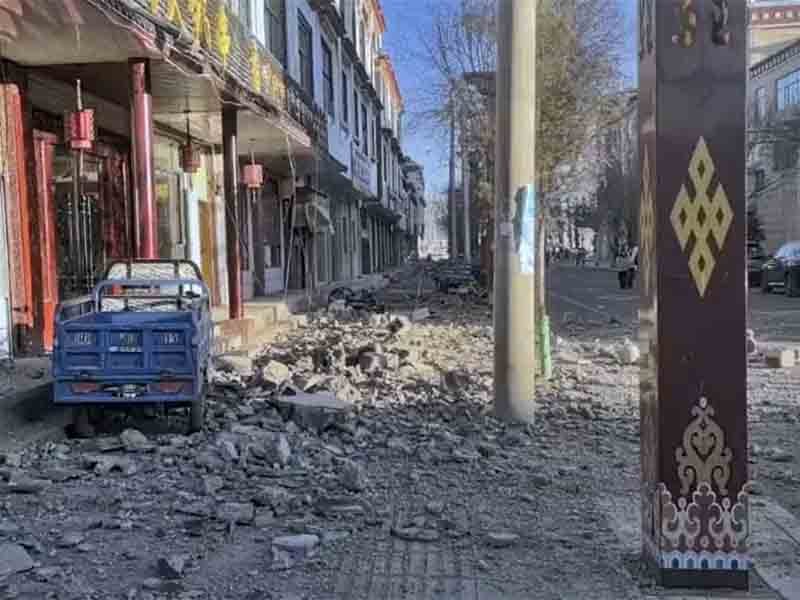- 7.1-magnitude earthquake in Tibet kills 53, injures 62.
- Over 1,000 homes damaged near Tingri, the epicenter.
- Tremors felt in Nepal, Bhutan, and India; no major damage reported.
- President Xi orders urgent rescue efforts for affected residents.
- Freezing temperatures and damaged infrastructure hinder rescue operations.
A devastating earthquake struck China’s remote Tibet region early Tuesday morning, killing at least 53 people and injuring 62 others. The powerful quake, with a magnitude of 7.1 according to the US Geological Survey (USGS), hit near Shigatse, a culturally and spiritually significant city in Tibet. The earthquake occurred at 9:00 a.m. local time (01:00 GMT), with its epicenter in Tingri county at a depth of 10 kilometers (6 miles).
Chinese state authorities recorded the earthquake with a slightly lower magnitude of 6.8. Early reports revealed widespread damage, with over 1,000 homes destroyed. Tremors were also felt in neighboring Nepal, Bhutan, and northern India. However, no casualties or significant damage were reported outside of China.
The Epicenter and Immediate Impact
Tingri county, located near the northern foothills of Mount Everest, endured the worst devastation from the earthquake. The sparsely populated area, home to about 6,900 people in 27 villages within a 20-kilometer radius of the epicenter, suffered extensive destruction.
Strong tremors shook the Shigatse region, home to 800,000 people. This area holds immense cultural and spiritual significance as it houses the traditional seat of the Panchen Lama, the second-most important figure in Tibetan Buddhism after the Dalai Lama.
Videos shared on Chinese social media depicted collapsed rooftops, debris-strewn streets, and damaged shop fronts in Lhatse county, approximately 86 kilometers (53 miles) from the epicenter. Surveillance footage from Shigatse captured scenes of residents fleeing buildings in panic as goods fell from shelves in supermarkets.
Rescue Operations and Challenges
Following the earthquake, the Chinese government initiated a large-scale rescue operation. Emergency response teams, along with the Chinese air force, were dispatched to the affected areas. Drones were deployed to reach remote and snow-covered regions where freezing temperatures have made relief efforts more difficult.
State broadcaster CCTV reported that by midday Tuesday, three villages had lost all communication. Rescue teams also faced challenges due to disrupted power and water supplies in the affected areas, further complicating their efforts.
President Xi Jinping urged local officials to prioritize the search for survivors. He emphasized the need to minimize casualties and ensure the safety and well-being of affected residents. He also called for swift action to resettle displaced communities and mitigate the impact of the disaster.
Regional Impact and Seismic Context
Tremors were felt as far away as Kathmandu, Nepal’s capital, located 400 kilometers (249 miles) from the epicenter. Local officials reported strong shaking but no immediate casualties or significant structural damage.
“We felt a very strong earthquake,” said Anoj Raj Ghimire, chief district officer of Solukhumbu district in Nepal, near Mount Everest. “So far, we have not received any reports of injuries or physical loss.”
In Bhutan’s capital, Thimphu, and India’s northern state of Bihar, residents experienced the tremors. However, officials confirmed that there were no casualties or property damage in these areas. Tibet’s position near the collision point of the Indian and Eurasian tectonic plates makes it highly susceptible to seismic activity. Experts from the China Earthquake Networks Center indicated that while major aftershocks are unlikely, minor tremors may persist.
Challenges of Rebuilding and Future Resilience
The Himalayan region has experienced several catastrophic earthquakes in recent decades. For instance, the 2015 earthquake in Nepal, with a magnitude of 7.8, killed nearly 9,000 people and injured 20,000. Similarly, the 2008 earthquake in China’s Sichuan province claimed almost 70,000 lives, underscoring the devastating effects of seismic activity in the region.
These frequent events highlight the need for robust disaster preparedness and resilient infrastructure in high-risk zones. Experts have consistently advocated for stronger construction standards and improved emergency response mechanisms, especially in remote and vulnerable areas prone to earthquakes.
As rescue efforts continue in Tibet, the focus is gradually shifting to rebuilding and ensuring the safety of affected communities. Harsh winter conditions and the inaccessibility of some villages have further complicated recovery efforts. These challenges emphasize the urgency of effective disaster recovery planning.
This earthquake is a grim reminder of the region’s vulnerability to seismic activity. While search-and-rescue efforts remain a top priority, long-term strategies to mitigate risks and enhance resilience are equally critical. Resilience must involve both physical infrastructure improvements and community-based preparedness initiatives.
In conclusion, the recent earthquake underscores the fragility of the Himalayan region and the need for collective action. Governments and organizations must invest in disaster risk reduction and learn from past events to minimize the impact of future natural disasters. Proactive measures can better protect communities and reduce the devastating consequences of such seismic events.


